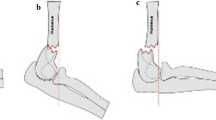Abstract
Introduction
Open reduction and plate fixation is known to reduce chances of malunion and symptomatic nonunion in displaced middle-third clavicle fractures. However, this treatment modality is also associated with several complications, such as hardware irritation, numbness around the surgical scar, infection, nonunion and implant failure. The minimally invasive plate osteosynthesis (MIPO) technique may reduce these complications.
Objective
To study clinical, radiological and functional outcomes of MIPO in AO/OTA type B displaced clavicle fractures and report any complications.
Materials and methods
A total of 22 patients underwent internal fixation of acute displaced AO/OTA type B clavicle fractures from Jan 2014 to Dec 2015 by MIPO using locking compression plates. Patients were followed up at a regular interval and assessed clinically and radiologically. The clavicle length difference was measured. Functional assessment was done at the end of 2 year using constant shoulder score (CSS) and disability of the arm, shoulder and hand score (Quick DASH) and complications if any were noted.
Results
All fractures united at a mean of 12.5 weeks. One (4.5%) patient had numbness around the surgical scar. None of the patients had wound-related complications. In four patients, hardware irritation was noted. The difference in clavicle length was not significant. All patients had excellent CSS and Quick DASH score at the final follow-up.
Conclusion
Internal fixation of displaced AO/OTA type B clavicle fractures by MIPO showed high fracture union rates and good functional outcomes.








Similar content being viewed by others
References
McKee MD (2015) Clavicle fractures. In: Court-Brown CM (ed) Rockwood and green’s fractures in adults, 8th edn. Wolters Kluwer, Alphen aan den Rijn, pp 1427–1473
Postacchini F, Gumina S, De Santis P et al (2002) Epidemiology of clavicle fractures. J Shoulder Elb Surg 11:452–456
Rowe CR (1968) An atlas of anatomy and treatment of midclavicular fractures. Clin Orthop Relat Res 58:29–42
Geddes CR, McKee MD (2013) Clavicle fractures. In: Sethi MK (ed) Orthopedic traumatology: an evidence-based approach. Springer, New York, pp 87–102
Postacchini R, Gumina S, Farsetti P et al (2010) Long-term results of conservative management of midshaft clavicle fracture. Int Orthop 34:731–736
Andersen K, Jensen PO, Lauritzen J (1987) Treatment of clavicular fractures: figure-of-eight bandage versus a simple sling. Acta Orthop Scand 58:71–74
Canadian Orthopaedic Trauma Society (2007) Nonoperative treatment compared with plate fixation of displaced midshaft clavicular fractures: a multicenter, randomized clinical trial. J Bone Joint Surg Am 89:1–10
Nowak J, Holgersson M, Larsson S (2004) Can we predict long-term sequelae after fractures of the clavicle based on initial findings? A prospective study with nine to ten years of follow-up. J Shoulder Elb Surg 13(5):479–486
Hill JM, McGuire MH, Crosby LA (1997) Closed treatment of displaced middle-third fractures of the clavicle gives poor results. J Bone Joint Surg Br 79(4):537–539
Robinson CM et al (2013) Open reduction and plate fixation versus nonoperative treatment for displaced midshaft clavicular fractures: a multicenter, randomized, controlled trial. J Bone Joint Surg 95(17):1576–1584
Böstman O, Manninen M, Pihlajamäki H (1997) Complications of plate fixation in fresh displaced midclavicular fractures. J Trauma 43(5):778–783
Duncan SF, Sperling JW, Steinmann S (2005) Infection after clavicle fractures. Clin Orthop Relat Res 439:74–78
Millett PJ, Hurst JM, Horan MP, Hawkins RJ (2011) Complications of clavicle fractures treated with intramedullary fixation. J Shoulder Elb Surg 20(1):86–91
Jung GH, Park CM, Kim JD (2013) Biologic fixation through bridge plating for comminuted shaft fracture of the clavicle: technical aspects and prospective clinical experience with a minimum of 12-month follow-up. Clin Orthop Surg 5:327–333
Lee HJ et al (2013) Percutaneous plating for comminuted midshaft fractures of the clavicle: a surgical technique to aid the reduction with nail assistance. Injury 44:465–470
Sohn HS, Kim BY, Shin SJ (2013) A surgical technique for minimally invasive plate osteosynthesis of clavicular midshaft fractures. J Orthop Trauma 27:92–96
Sohn HS, Shin SJ, Kim BY (2011) Minimally invasive plate osteosynthesis using anterior–inferior plating of clavicular midshaft fractures. Arch Orthop Trauma Surg 132:239–244
March JL et al (2007) Orthopaedic trauma association classification, database and outcomes committee. Fracture and dislocation classification compendium 2007. J Orthop Trauma 21(10):S72–S74
Constant CR, Murley AH (1987) A clinical method of functional assessment of the shoulder. Clin Orthop Relat Res 214:160–164
Fabre T, Piton C, Leclouerec G, Gervais-Delion F, Durandeau A (1999) Entrapment of the suprascapular nerve. J Bone Joint Surg Br 81(3):414–419
Hudak PL, Amadio PC, Bombardier C (1996) Development of an upper extremity outcome measure: the DASH (disabilities of the arm, shoulder and hand). Am J Ind Med 29(6):602–608
Sohn HS (2015) Comparison between open plating versus minimally invasive plate osteosynthesis for displaced clavicular shaft fractures. Injury 46(1):1577–1584
Jiang H, Qu W (2012) Operative treatment of clavicle midshaft fracture using locking compression plate: comparison between mini-invasive plate osteosynthesis (MIPPO) technique and conventional open reduction. Orthop Traumatol Surg Res 98:666–671
Zhang Y, Xu J, Zhang C, Sun Y (2016) Minimally invasive plate osteosynthesis for midshaft clavicular fractures using superior anatomic plate. J Shoulder Elb Surg 25:7–12
Lazarides S, Zafiropoulos G (2006) Conservative treatment of fractures at the middle third of the clavicle: the relevance of shortening and clinical outcome. J Shoulder Elb Surg 15(2):191–194
Tyler Nathe MD, Susan Tseng MD, Brad Yoo MD (2011) Supraclavicular nerve anatomy at the clavicle. Clin Orthop Relat Res 469(3):890–894
Author information
Authors and Affiliations
Corresponding author
Ethics declarations
Conflict of interest
The authors declare that they have no conflict of interest.
Rights and permissions
About this article
Cite this article
Kundangar, R.S., Mohanty, S.P. & Bhat, N.S. Minimally invasive plate osteosynthesis (MIPO) in AO/OTA type B displaced clavicle fractures. Musculoskelet Surg 103, 191–197 (2019). https://doi.org/10.1007/s12306-018-0577-1
Received:
Accepted:
Published:
Issue Date:
DOI: https://doi.org/10.1007/s12306-018-0577-1




